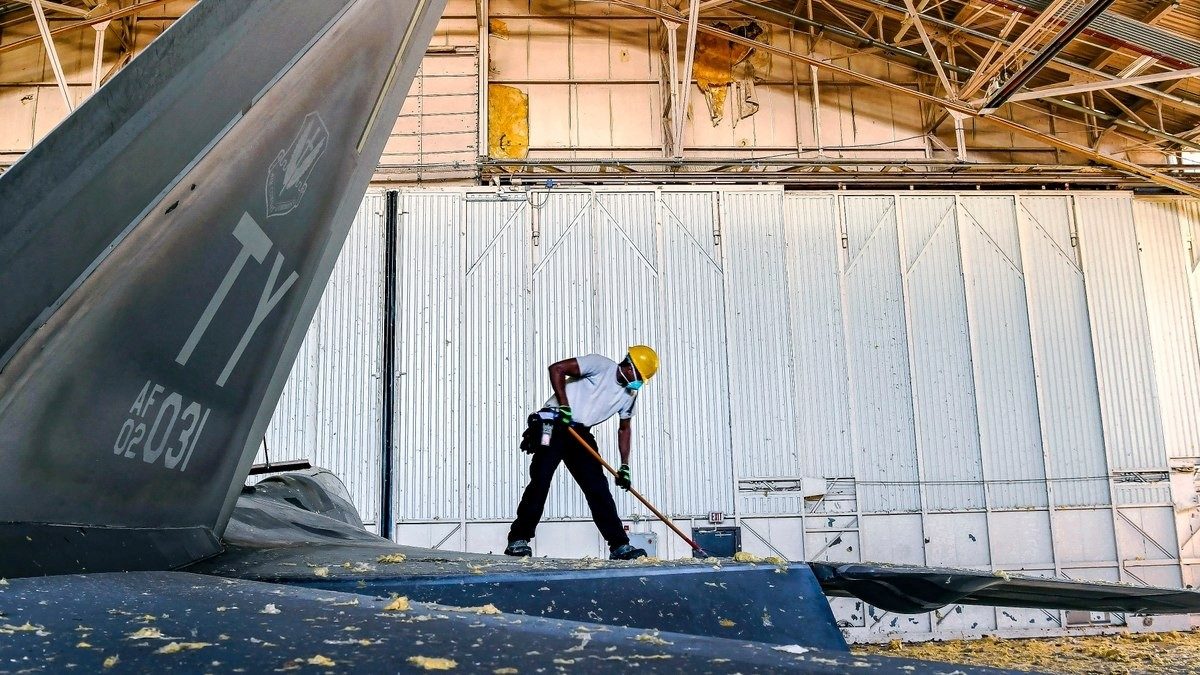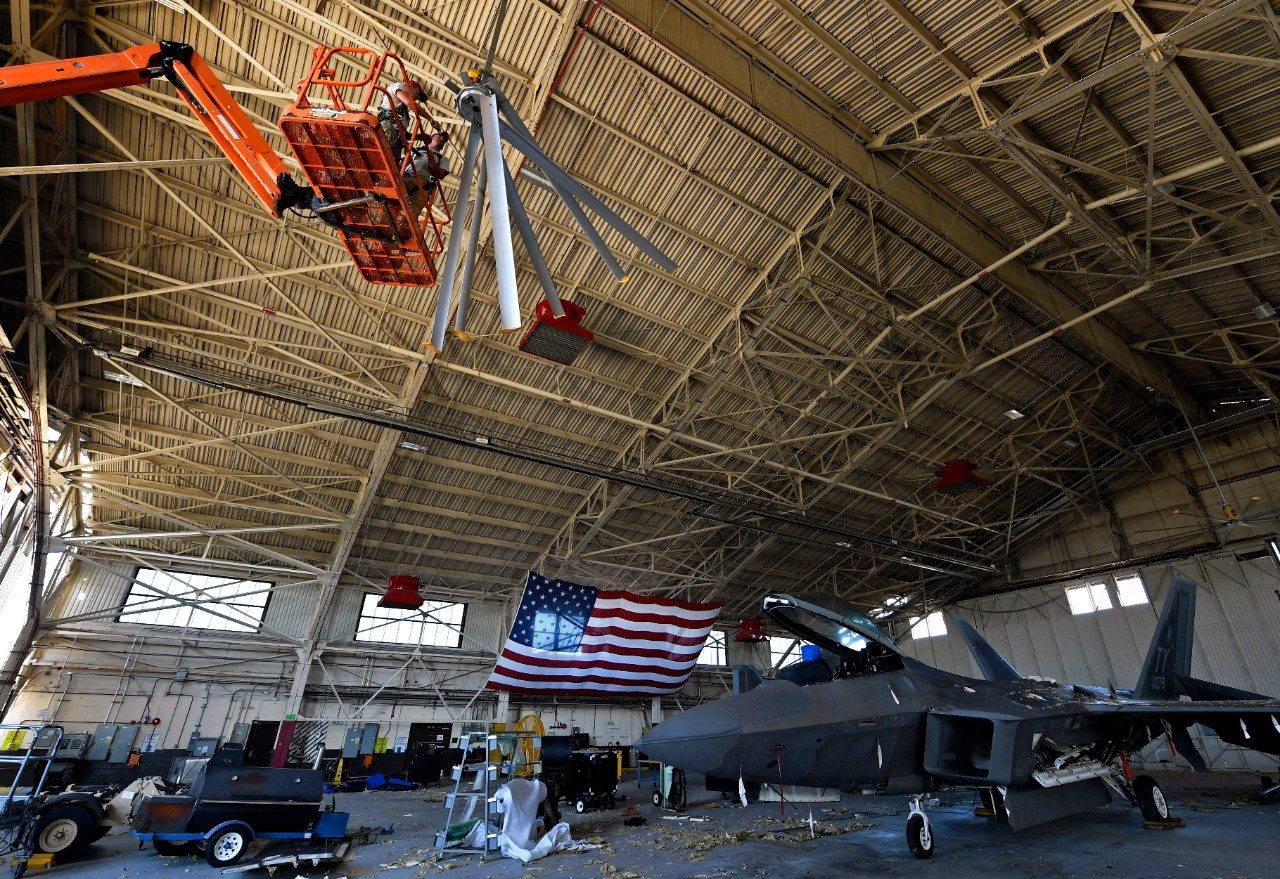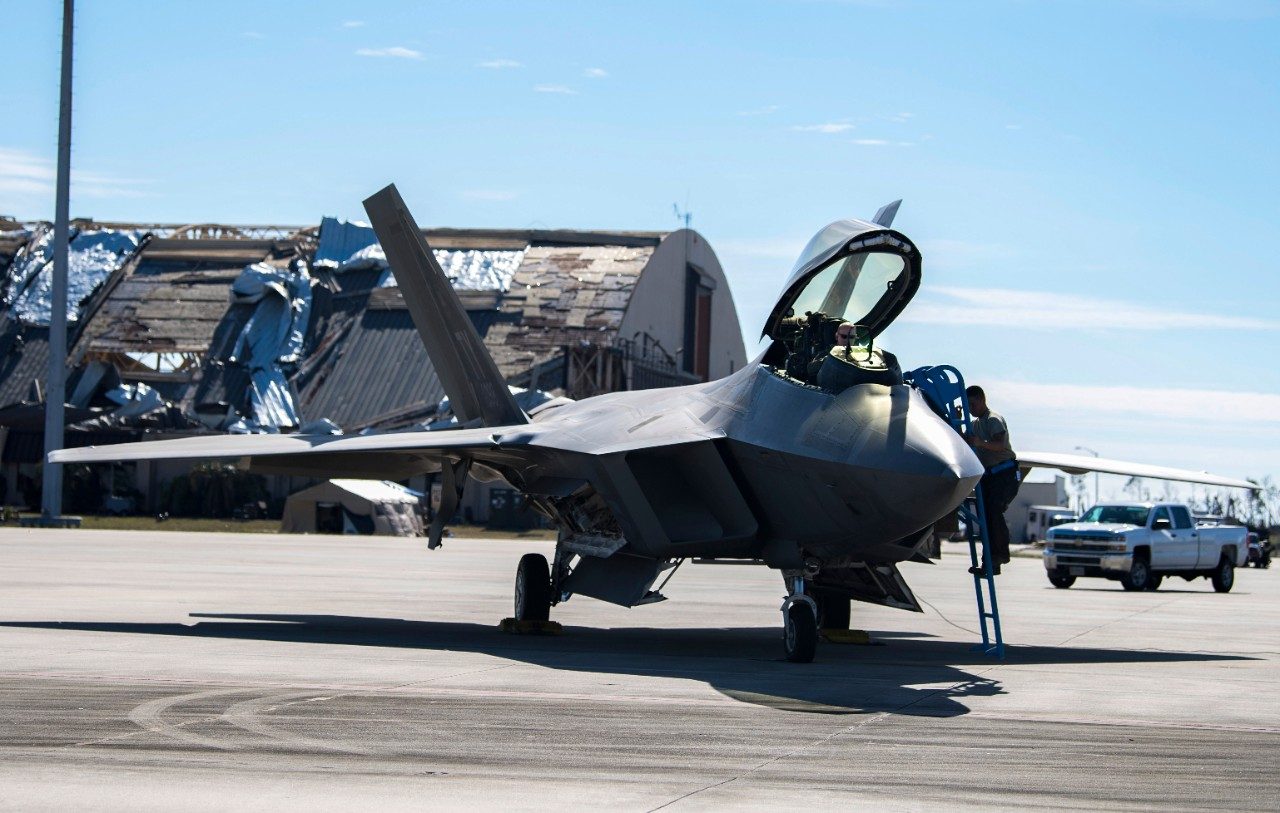The F-22 Raptor continues to dominate the skies, unmatched by any adversary. In October 2018, the sky itself threatened to damage or destroy the sizable F-22 fleet stationed at Tyndall Air Force Base, Florida, during Hurricane Michael.
Hurricane Michael, a Category 5 storm, struck the Florida panhandle and left a path of destruction in its wake. Lives, businesses, infrastructure and communities were impacted, including Tyndall. Michael was one of the largest hurricanes to ever hit the United States, and the biggest storm to impact Florida since Hurricane Andrew, a Category 5 storm, in 1992.
At the time Tyndall was home to 55 F-22s ‒ approximately 30 percent of the U.S. Air Force’s Raptor fleet ‒ operated by 43rd Fighter Squadron, a training unit, and the 95th Fighter Squadron, a combat-coded squadron.

Michael Totals Tyndall
While most of Tyndall’s F-22s departed to other bases before the hurricane hit, 17 Raptors were left to ride out the storm. The remaining Raptors were either undergoing planned maintenance or could not be safely launched on very short-notice.
Thankfully, all 11,000 personnel and family members were also safely evacuated before the storm hit. U.S. Air Force leaders rightly prioritized, above all else, the safety of those under their command.
Tyndall’s flightline was decimated. Large roof sections were ripped from aircraft hangars and several buildings completely collapsed as sustained winds of up to 155 mph pummeled the base. Hurricane Michael damaged 95 percent of the buildings at Tyndall.
“It’s just a mess. I’ve seen several hurricane results, and this is probably the worst one I’ve ever seen from a facility and environmental perspective,” said Brett Haswell, director of F-22/F-16 Field and Depot Operations.
“The facilities are in really bad shape,” he added, noting that about 70 percent of the buildings would need to be bulldozed. “Some things are up and running. Some [departments] are using deployable tents as operating facilities.”
Raptors Rise from the Ashes
Despite the extensive damage Hurricane Michael caused at Tyndall, the F-22s at the base rode out the storm relatively unscathed.
“We do not have any destroyed aircraft at Tyndall,” U.S. Air Force spokesman Brig. Gen. Ed Thomas said after an initial damage assessment. “All of these aircraft are upright with all of their noses and their tails and their wheels and their wings and their vertical stabilizers in those hangars.”
The last four F-22s that remained at Tyndall arrived at Langley Air Force Base, Virginia, on Nov. 16. The four aircraft are repairable but sustained damage in multiple areas including coatings, doors, canopies, leading edge and engine inlet.
“We are currently assessing repairs and should be up and running by mid-April. Work on the final plane ‒ full-life repairs and low observable coating ‒ will be completed this summer” Haswell said.
All Hands Effort
Lockheed Martin engineers located at nearby Eglin Air Force Base, Florida, about 70 miles from Tyndall, also supported the recovery of Tyndall’s F-22 fleet. The company also sent additional personnel to assist with the aircraft relocation and support.
“We sent an avionics expert, a structural expert and a structural engineer to help assess jets to see which ones could be flown out, which ones could be fixed, and which ones needed to be patched or panels changed following the storm,” Haswell said.
These team members also helped the Air Force maintainers assess what needed to be repaired or replaced. The remaining 17 jets were sent to different bases on Nov. 16, 2018.
Four jets needed to have the canopy’s changed and several panels needed to be swapped. Three jets needed tempory repairs to be flown out. In some cases, spare parts and panels were borrowed from the Joint Base Langley-Eustis fleet to be send back to Tyndall AFB so the plane could be flown back to Joint Base Langley-Eustis.
“It took about a month to get the job done,” Haswell added. “The good news is that all the air planes flew out. None of them were damaged severely and we will have them all fixed this year.”

Keeping the Raptors Ready
The U.S. Air Force continues to rely on the F-22 to ensure America’s asymmetric, unfair advantage over adversaries, today and well into the future. The Air Force currently plans to operate the F-22 for another four decades ‒ until the 2060 timeframe.
The F-22 team has worked tirelessly for more than two decades to ensure the Air Force’s Raptor fleet is ready. The Pentagon’s recent directive that all U.S. tactical aircraft, including F-22s, must meet an 80 percent mission capable rate has raised the bar even higher for the F-22 fleet.
“Our goal for the year is 80 percent [mission-ready], which will be a big challenge but we’re ready,” said Haswell, who noted that existing supply chain constraints and storm-related repairs created a unique set of challenges for the Raptor fleet.
To support the Air Force’s F-22 fleet, Lockheed Martin is opening a third bay at the company’s F-22 Inlet Coating Repair (ICR) Speedline in Marietta, Georgia, which specializes in F-22 low observable coating. An extra bay means these aircraft can be repaired quickly and placed by into the operational Raptor fleet. Two low observable coating bays are also located at Eglin, where repair work is also being supported.
Lockheed Martin has also modified the tempo of its Contractor Field Teams (CFT) located at other Raptor bases including Joint Base Langley-Eustis, Virginia; Joint Base Elmendorf-Richardson, Alaska; and Joint Base Pearl Harbor-Hickam, Hawaii. Those teams switched from a five-day, two-shift operation, to seven-day, two-shift operations. This has doubled the personnel available to perform F-22 repair work, resulting in more flying hours and less downtime for the Raptor fleet.
Raptors Relocating
While Tyndall is undergoing repairs that could take several years, F-22s assigned to the 43rd and 95th Fighter Squadrons have found new homes. The 43rd is relocating to Eglin AFB, and the 95th’s Raptors are being assigned to other U.S. Air Force F-22 units, including JB Langley-Eustis, JB Elmendorf-Richardson, and JB Pearl Harbor-Hickam.
"We have recommended that the best path forward to increase readiness and use money wisely is to consolidate the operational F-22s formerly at Tyndall in Alaska, Hawaii and Virginia," Air Force Secretary Heather Wilson said in December 2018.
Florida politicians have strongly supported a U.S. Air Force recommendation to use supplemental funds to eventually locate three F-35 squadrons at Tyndall. Under the proposal, as many as 72 F-35s would be based at Tyndall, beginning in 2023.
Virginia lawmakers have also urged the Air Force to permanently move some of the F-22s formerly at Tyndall to JB Langley-Eustis.
“Regardless of what happened during Hurricane Michael, the F-22 fleet will continue to grow stronger and more capable because of the dedicated people who make up our partnership with the U.S. Air Force and our shared focus on readiness,” said Evan Miller, director of Integrated Fighter Group Sustainment Operations.





